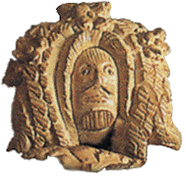...Best of Sicily
presents... Best of Sicily Magazine. ... Dedicated to Sicilian art, culture, history, people, places and all things Sicilian. |
by Antonella Gallo | ||
Magazine Index Best of Sicily Arts & Culture Fashion Food & Wine History & Society About Us Travel Faqs Contact Map of Sicily |
The bread sculptor's art transcends religious figures. Objects (swords, palm fronds, crosses) and animals (lambs, fish) are also created. Sometimes the bread is stuffed with figs and other delights. It can also be coloured, though purists avoid this practice. Bread sculpture owes its religious significance to Christian liturgical tradition, which celebrates bread as the body of Jesus Christ. Then there is the blessing of the votive bread, not to be confused with the Eucharistic of the Mass. In Sicily, once the "granary of the roman Empire," it is no wonder that bread, of all things, would be used to express popular devotion. The technique itself is not as simple as it may at first glance seem. Recipes are inherited, passed from one baker to another over generations. The amount of yeast used to make the bread expand perfectly while baking, without impeding the realisation of the forms desired, must be exact. Often, very little yeast is included at all. Each locality has its distinctive forms, often quite stylised, sometimes linked to the veneration of a local patron saint or even a local event. The more ornately crusted works of art, which may be remarkably detailed, are intended more for display than eating. The very thought of bread sculpture is delicious. About the Author: Artist Antonella Gallo teaches art in Rome. | |
Top of Page |
 Nobody knows precisely when the tradition began, but decorative "votive" bread has been popular in Sicily for centuries. It is part of a wider Mediterranean practice known in Greece and other countries, and probably can be traced to Sicily's Greek Orthodox past. Paschal (Easter) bread is just one part of this colourful culinary tradition, known throughout southern Italy and associated with many local customs. Sicily's more creative bakers often reveal their talent as sculptors for other religious feasts, such as those of Saint Joseph, Saint Martin and Saint Agatha. Christmas is another occasion for bread sculpture, with nativity scenes dominating during the holiday season.
Nobody knows precisely when the tradition began, but decorative "votive" bread has been popular in Sicily for centuries. It is part of a wider Mediterranean practice known in Greece and other countries, and probably can be traced to Sicily's Greek Orthodox past. Paschal (Easter) bread is just one part of this colourful culinary tradition, known throughout southern Italy and associated with many local customs. Sicily's more creative bakers often reveal their talent as sculptors for other religious feasts, such as those of Saint Joseph, Saint Martin and Saint Agatha. Christmas is another occasion for bread sculpture, with nativity scenes dominating during the holiday season.